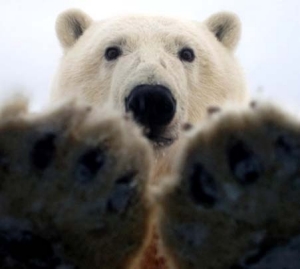Polar Bears Sniff Paw Prints to Find Love

By Julianne Glaser
Polar bears live largely solitary lives camouflaged on the snowy arctic tundra, one of the coldest places on Earth. This barren environment lacks the trees and rocks that solitary bears in more temperate environments typically use to mark their territory with urine and body scents. So how do polar bears leave messages for other bears that may be many miles away?
Finding Mates Through Scented Feet
Pioneering research has revealed that polar bears have adapted to their inhospitable habitat by excreting their scent through their paws and then tracking it in the snow as a means of communication. According to a recent collaborative study, polar bears imprint a unique scent in every step of their trek across the frozen terrain in order to establish dominance and, more importantly, to locate potential mates. This communication method takes advantage of the bear’s excellent sense of smell, one that allows them to detect seals nearly a mile away!
To test this theory, researchers from the San Diego Zoo, Polar Bears International in Bozeman, Montana, and the Alaska Science Center collected paw scent samples from hundreds of wild polar bears during breeding season. They swabbed the scents onto cardboard boxes to create “scent boxes,” and exposed 26 captive polar bears from 10 different North American zoos to these wild scents to analyze their reactions. Researchers measured the bears’ interest in the scents by their approach to the box, sniffing and “flehmen response”—a special way of smelling in which an animal curls back its upper lip and gathers scent in its mouth.
Research results showed that captive polar bears were far more interested in paw scents from the opposite sex; males preferred the paw scent of fertile females over non-fertile females, and both male and female polar bears were more intrigued by the scent boxes around spring breeding season than any other time of year. “Effective communication is essential for successful reproduction in solitary, wide-ranging animals,” said Dr. Megan Owen, lead author of the study. This research verifies that polar bears use scented paw signals to locate mates during their solo voyages across the tundra.
Forensic Investigation
Dissection of two polar bears that had died of natural causes revealed prominent sweat and oil glands in their paws, which are most likely responsible for their signature paw scents. Researchers note that this communication method depends upon the condition of the polar icecaps—once the ice melts and fragments, so do the scent trails, and the polar bears lose this essential means of communication.
Extension Questions
- Why do bears generally live solitary lives?
- What other ways can polar bears communicate once the snow and ice melt?
- How many species of bears exist and where do they live?